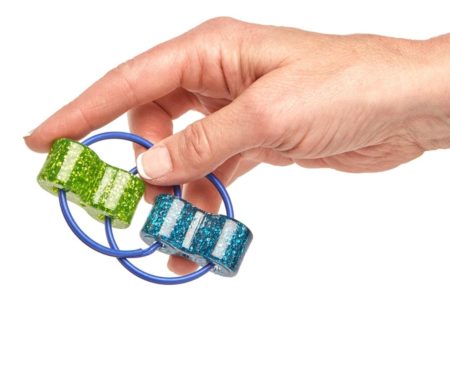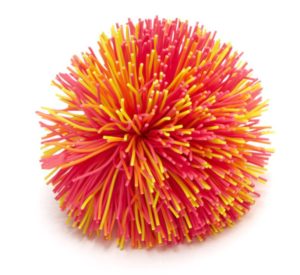Finding the Right Fidget for ADHD & Sensory Needs
Fidgeting has gone mainstream over the past year with the rapid rise of Fidget Spinners and Cubes. However ADHD Fidget Toys have been and always will be a mainstay for folks with neurological challenges — Autism Spectrum Disorders (ASD), Sensory Processing Disorder (SPD), ADHD and others. With the help of Matthew, a young man who knows ASD firsthand and his mom Jane, we wanted to share an insider’s perspective on the right fidget toy for any sensory diet. “If my son is feeling stressed or is experiencing sensory overload,” Jane says, “he knows can use fidgets for ‘self-regulation’ — to help him find his calm, and get focused, centered, or organized.”
Understanding your Sensory Diet
For folks with ADHD or those on the autism spectrum, fidgeting is not a one-size-fits-all solution. Understanding the variety of sensory needs can help you hone in on the tools or resources that would be best for each individual. Even then, you might have to try a few to figure out which tools best help create an ambiance of calm and focus.
Stimming

LOOPEEZ $3.95 BUY NOW
Stimming, short for Self-Stimulation, refers to self-soothing behaviors. For those who find repetitive motions to be calming, these fidget tools might be good picks:
- Gyrobi & Gyrobi Squared – hold the outer loop and spin any one of the concentric circles or squares.
- Bendeez – flex the covered wire back and forth or form the line into a wiggly shape.
- Tangle – coil the loop of plastic arcs around a finger or twist and turn the segments into any number of interesting shapes.
- Flexygon – move the silicon hexaflexagon in an endless rotation.
- Loopeez & Loopeez Jr – move the rings in an infinitely looping rotation.
- Glitter wand – turn the wand over and over, up and down, and watch the sparkly liquid move through the clear tube.
- Infinity Cube – open and refold the cube in an endless, repetitive motion.
- SwingOs – move the three “O” shapes round and round.
- Nuts & Bolts – thread the nut onto the bolt and then keep twisting and untwisting.
Visual Perception
Those with Visual Perception sensitivity (a.k.a. Scotopic Sensitivity Syndrome and the Irlen Lens System) might find that light, glare, busy patterns and reflection cause stress. They might also find that single-colored objects are more to their liking. If the goal is to avoid visual perception overload, you might like these:
- Gyrobi (one-color) – although Gyrobi is sold as a multi-color fidget toy, the outer rings can easily be pulled apart so you can reassemble the spinning toy into one color.
- Tangle (one-color) – arc segments can easily be snapped apart and back together, allowing users to create to modify the toy to their liking. In addition, many single-colored Tangle Toys are also available. To use, simply turn the arc segments into any number of visually interesting shapes.
- Tridget – the matte finish on the Tridget ensures that the color is not overwhelming. The blue/green option is calming, yet interesting.
- Puffer ball – the air-filled balls are pleasing to the touch and come in a range of vibrant colors — find the right color and you’re all set!
- Magni-Stones (8+ years old) – magnetic Magni-Stones aren’t much to look at, but their strong magnetic pull is quite satisfying. They’re shiny, but don’t glare.
- Smiley Stress Ball – foam stress toys or squeeze balls come in seemingly endless shapes, objects, and colors.
- Pipe cleaners – with fuzzy, flexible pipe cleaners you’re only limited by your creativity. Plus, they’re available in tons of colors!
Tactile
 Some with SPD find certain textures particularly soothing. Several fidget toys offer interesting tactile experiences. Favorites include:
Some with SPD find certain textures particularly soothing. Several fidget toys offer interesting tactile experiences. Favorites include:
- Tangle Therapy – has the same wonderfully flexible arc shapes, combined with an assortment of textures — smooth, bumpy, rubbery.
- Brain Noodles – these “pipe cleaners on steroids” are super fuzzy and flexible so you can simply smooth your hand over them or shape them into anything you can imagine.
- Spiky Massage ball – the ball is firm, not squishy; and the spikes are dull, not pointy. Put it together and it feels great on your hand, feet, or back.
- Koosh ball – the iconic Koosh ball, with its 100s of rubbery strands, has a feel like none other.
- Puffer balls – squeeze the air from one end of the puffer ball to the other. We can’t guarantee that it will never pop, but it does feel good!
- Loopeez – move the rings in an infinitely looping rotation.
- Traxx – smooth surface and multi-directional flexing and swiveling makes this a nice tactile experience.
Fine Motor
Dyspraxia, or movement difficulties, are not uncommon for those with neurological challenges. If you’re looking to build fine motor skills, strengthen finger muscles, or develop eye-hand coordination, we suggest these:
- Gyrobi & Gyrobi Squared – hold the outer loop and spin any one of the concentric circles or squares.
- Jeliku – extend the concentric square shapes into a line, or flex them into a number of cool shapes.
- Twiddle – form the micro-links into a large bold shape or a more intricate pattern.
- Fiddlink – developed for fiddlers to improve the finger dexterity, Fiddlink can be manipulated with one hand or two.
- Infinity Links – rotate the chunky pieces in an infinite loop.
- Wacky Tracks / Klixx – flex individual links to form any number of shapes and patterns.
- Pipe cleaners – with fuzzy, flexible pipe cleaners you’re only limited by your creativity. Use one color or multiple colors, and then form them into any shape!
- Loopeez – move the rings in an infinitely looping rotation. These are available in large and small sizes. The smaller bike-chain style fidgets offer the same motion.
Proprioceptive Input
Proprioceptive Systems refer to ones’s ability to sense where he (/she) is in relationship to his surroundings. For those with proprioceptive sensitivities who might be prone to avoid touching and physical activity, these fidget toys could channel some productive movement:
-
- Brain Putty – kneading putty and dough
- Stretchy String – stretch the safe and very elastic string as far as your arms can reach. Integrate it into a number of yoga positions
- Stretch & Bounce, Isoflex balls, Moody Dude balls – these can all be stretched, kneaded and formed into playful shapes
- Pipe cleaners – with fuzzy, flexible pipe cleaners you’re only limited by your creativity. Use one color or multiple colors, and then form them into any shape!
- Squiggle Tube – the air-filled puffer tubes are great to pull and stretch.
- Chewing toys – Therapy Shoppe offers a range of chewable items and “Chewelry” that are bpa, phthalate, lead and latex free.
Sound Perseveration
Sound perseveration refers to an individual’s need to repeat the same sound or language over and over. Although word phrases are often found to be distracting in class, the sounds made by some fidget toys may be an optimal compromise. For instance:
- Wacky Tracks / Klixx / Snap and Click – these segmented fidget toys make a soft sound when flexed into different positions. If you’re looking for silence, they’re not good choices, but they’re not crazy loud either. And, they can be formed into lots of interesting shapes.
- Magni-Stones – because of the strong magnetic force, the stones make a bit of a clicking sound when they come together. Again, while they aren’t super loud, we can’t put them in a silent category either!
Finding the right ADHD Fidget Toys
We understand that every person with a sensory disorder, ADD, ADHD, or whatever, has different symptoms, needs, and preferences. We don’t profess to be medical experts and appreciate that it may take some trial and error to find the right fidget toys for your needs. And even then, “the right” fidget tool for today may not be the right one for tomorrow. That’s just how it goes. If you want to start building your own “Comfort Kit,” visit Trainers Warehouse and find the fidgets that will bring focus and calm to your world.
Meanwhile, rest assured that we’re always on the lookout for new tools and toys to satisfy a range of sensory diets. We hope you’ll let us know your recommendations for specific needs, so that we can continue to update this list.
SHOP NOW!
READ MORE
Which Fidget Toys are Best for You?

